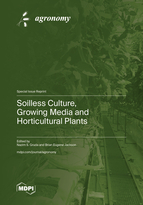Soilless Culture, Growing Media and Horticultural Plants
A special issue of Agronomy (ISSN 2073-4395). This special issue belongs to the section "Horticultural and Floricultural Crops".
Deadline for manuscript submissions: closed (25 August 2020) | Viewed by 125408
Special Issue Editors
Interests: vegetables; climate change; horticulture; soilless culture; growing media; protected cultivation; greenhouse production
Special Issues, Collections and Topics in MDPI journals
Interests: wood substrates; bark substrates; engineering raw materials; substrate particle dynamics; substrate hydrology; container plant root growth; substrate analytical methods
Special Issues, Collections and Topics in MDPI journals
Special Issue Information
Dear Colleagues,
Horticultural crops, such as vegetables, floral crops, ornamentals, and fruits, have become essential components of aesthetics and nutrition in our daily life. Production technology affects not only the plant growth and yield, but also the overall plant quality, improving in turn the cumulative benefits of plants. Soilless culture systems, as part of extensive and sustainable methods for the future of crop production, has rapidly expanded throughout the world particularly in the areas having shortage of water supply and quality soil. The increased production of crops in controlled environment systems around the globe has been further accelerated by the increased interest in growing small/soft fruit crops, greens, herbs, and Cannabis in soilless container systems. These systems are used in addition for production of hydroponic and pot ornamentals, seedlings and transplants, and for increasing of plant metabolites in medicinal and aromatic plants. Currently, soilless cultures have received a great interest and are used in urban farming, green infrastructure projects which include vertical garden systems, green roofs, and rain gardens. The demand for soilless substrates continues to increase around the world as does the need for novel research to address problems and continue creating opportunities for this industry.
The purpose of this special issue is to publish high-quality research articles addressing recent developments on cultivating horticultural plants in soilless culture and growing media. The present special issue aims to provide contributions from a variety of current relevant topics in the horticultural sciences, physiology, root medium properties, plant propagation, plant nutrition and chemistry, substrate hydrology and physics, compost and waste management, engineering as well as all other research fields familiar with soilless culture and growing media.
Prof. Dr. Nazim S. Gruda
Assoc. Prof. Brian E. Jackson
Guest Editors
Manuscript Submission Information
Manuscripts should be submitted online at www.mdpi.com by registering and logging in to this website. Once you are registered, click here to go to the submission form. Manuscripts can be submitted until the deadline. All submissions that pass pre-check are peer-reviewed. Accepted papers will be published continuously in the journal (as soon as accepted) and will be listed together on the special issue website. Research articles, review articles as well as short communications are invited. For planned papers, a title and short abstract (about 100 words) can be sent to the Editorial Office for announcement on this website.
Submitted manuscripts should not have been published previously, nor be under consideration for publication elsewhere (except conference proceedings papers). All manuscripts are thoroughly refereed through a single-blind peer-review process. A guide for authors and other relevant information for submission of manuscripts is available on the Instructions for Authors page. Agronomy is an international peer-reviewed open access monthly journal published by MDPI.
Please visit the Instructions for Authors page before submitting a manuscript. The Article Processing Charge (APC) for publication in this open access journal is 2600 CHF (Swiss Francs). Submitted papers should be well formatted and use good English. Authors may use MDPI's English editing service prior to publication or during author revisions.
Keywords
- Advances in peat use sustainability
- Advances in urban gardening, green roof technology, and vertical farming
- Asexual propagation and grafting
- Fruit production in container/soilless production
- Growing media additives
- Growing medium
- Increasing of plant metabolites
- LCA and climate change
- Novel inorganic and organic materials as soilless media
- Nutrient Film Technique, hydroponics and aquaponics
- Nutrient solution
- Organic waste management
- Peat alternatives
- Reduction of abiotic and biotic stresses
- Root medium properties and plant nutrition
- Soilless substrates
- Substrate analysis technologies
- Water use efficiency







